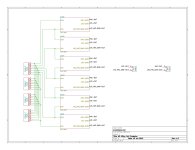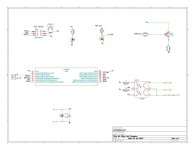dmwahl
10 kW
Why would you use the mounting holes if the board is in a eurocard enclosure? It's sized to fit into the card rails. I added the mounting holes because I can't stand anything without them, but they aren't always needed.powersupply said:dmwahl, off the bat, I noticed a few things and I just let them out as they are.
Please consider some mounting holes which would not collide with possible sliding rails of eurocard enclosures.
Yes, perhaps, although heat transfer is a complicated beast, I've spent years doing it professionally for military/industrial computer boards and there's no one rule like that that always holds true. A lot of heat transfer out of leaded power resistors is through the leads, but standing them on end makes them more prone to mechanical damage. What you can't see in the render I posted is that the back side has a large copper flood connected to one of the leads.Power resistors can get rid of heat WAY much better if you stand them up (in case you have the headroom).
I don't quite follow what you're trying to do here, do you have a picture you can share?I would also suggest some staggered connectors for folks like me who have 4s1p (or 5s) packs.
F.I I am using 13s4p made out of 13 4s1p hardcase packs.
I would solder the socket for the first pack into C1..C5 no problem.
But where do I solder the socket for the 3 pins I removed from the next 4s connector?
This is missing from every approach I have seen.
There silkscreen outlines are larger than the actual parts, I've printed the layout on paper to check component clearance and had no issues. Hard to tell from the render though.I think you place your stuff way too close to the edges of your layout.
?Just skip one stage , how many would need a 36s unit?
I appreciate the feedback. BOM cost for 13S would probably be around $45 from Digikey. Most of the parts can also be found on ebay for less if you don't mind waiting for shipping from china.Please keep in mind that I have not really aquainted myself with your design, so if something is off I apologize in advance.
Just posted this as I had the impression that you want to order the PCBs.
How much is the total cost of the BOM for a 13s setting BTW?
I haven't had any issues with stability. How did you solve the problem of knocking out PICs with a phone? Were they actually damaged?One major concern I have with using mictocontrollers is their operative reliability.
None of these BMS units -be it DIY or produced- have any type of safeguarding against most common EMF or similar external disturbances.
Even with watchdogs active we could knock out PICs by just holding one of those nasty Nextel phones close to them while calling the phone.
Based on your experiences, did you ever have a unit go berserk and you had to reset it to work again?
Thanks again for the comments.



